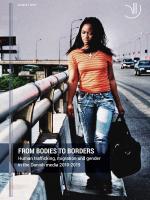New DIIS report on human trafficking puts the Danish media-coverage under a critical spotlight
In recent decades, news media all over the world have increasingly covered the issue of human trafficking. Human trafficking is a notoriously complex subject involving migration, border politics, gender, consent, agency and morality. Yet, simplistic ideas and framings of human trafficking often end up shaping broader understandings of human trafficking in policy and the public sphere.
This report is written by DIIS Senior Researcher Sine Plambech and journalist Maria Brus Pedersen. The aim is not only to provide insights into the framing of human trafficking in the Danish media, but furthermore to serve as a learning tool for journalists covering human trafficking. An analysis of this type has not been undertaken in Denmark before and thus provides the reader with new insights into the evolution of how the Danish media framed human trafficking from 2010 to 2019.
The report has three main findings:
First, the framing of human trafficking in the Danish media has changed significantly over the past decade, from mainly covering human trafficking solely as a matter of prostitution and a human rights issue for women in 2010 to becoming an issue of migration with security and legal implications in 2019. As such there has been a development away from a focus on women’s ‘bodies’ to a focus on ‘borders’ and migration politics.
Secondly, in comparison to 2010, today the media more commonly describe the trafficking of men to forced labor and human trafficking generally to other sectors than prostitution. Yet, the framing continues to be significantly gendered. Though identified victims of trafficking in Denmark are most usually migrants, the men are framed primarily as migrant workers in exploitative situations, whereas the women are described as victims of trafficking. This gendered framing derives primarily from the perspective that prostitution is victimizing by default and is not seen as a kind of work.
Thirdly, despite the more nuanced framing, a simplistic sensationalist language still risks dehumanizing and overshadowing the complexity of human trafficking. In particular, this is because it is the media, rather than those who have been identified as victims of trafficking, who use these terms to describe their situation, as some of the journalists also confirmed.
The report has a number of suggestions for journalists covering issues of human trafficking, some of them being;
- Be cautious with language. There is often a difference between the language used by politicians and NGOs and the language used by migrant workers to describe their situations. Sensationalist language like ‘prostitutes’, ‘sex slaves’ and ‘meat markets’ are loaded terms that contribute to marginalization and stigmatization.
- Migrant workers are not only victims of trafficking, they have agency in respect of their own migration trajectories: the one does not exclude the other.
- Human trafficking can be used as a yardstick for many different political agendas: consider which agendas you might be contributing to.
- Consider using counter narratives, activist reporting and investigative journalism as these approaches contribute to expanding our understanding of human trafficking.
This report is published by DIIS · Danish Institute for International Studies with funding from the Council of the Baltic Sea States (CBSS), in partnership with the Danish Ministry of Foreign Affairs.
DIIS Experts


